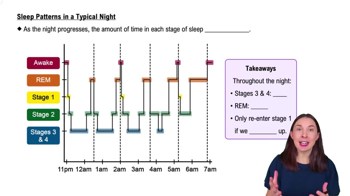Table of contents
- 1. Introduction to Psychology1h 43m
- 2. Psychology Research2h 20m
- 3. Biological Psychology2h 41m
- 4. Sensation and Perception28m
- 5. Consciousness and Sleep32m
- 6. Learning41m
- 7. Memory34m
- 8. Cognition37m
- 9. Emotion and Motivation35m
- 10. Developmental Psychology33m
- 11. Personality48m
- 12. Social Psychology41m
- 13. Stress and Health41m
- 14. Psychological Disorders44m
- 15. Treatment47m
5. Consciousness and Sleep
Sleep
Struggling with Psychology?
Join thousands of students who trust us to help them ace their exams!Watch the first videoMultiple Choice
While walking down the street, Preeti sees a large, snarling dog on the sidewalk. She immediately appraises the situation as dangerous, experiences fear, and becomes aroused. Preeti's response to the dog is best explained by
A
Schachter and Singer's cognitive arousal theory.
B
the Cannon-Bard theory.
C
the James-Lange theory.
D
Lazarus's cognitive-mediational theory.
 Verified step by step guidance
Verified step by step guidance1
Identify the key components of the scenario: Preeti sees a dog, appraises the situation as dangerous, experiences fear, and becomes aroused.
Understand that Lazarus's cognitive-mediational theory emphasizes the role of cognitive appraisal in the emotional response process.
Recognize that according to Lazarus, the appraisal of the situation (seeing the dog as dangerous) occurs before the emotional response (fear and arousal).
Compare this with other theories: Schachter and Singer's theory involves physiological arousal and cognitive labeling, Cannon-Bard suggests simultaneous emotion and physiological response, and James-Lange posits that physiological response precedes emotion.
Conclude that Lazarus's theory best explains Preeti's response because it highlights the importance of her cognitive appraisal in determining her emotional reaction.

 3:25m
3:25mWatch next
Master Circadian Rhythms with a bite sized video explanation from Hannah Gordils
Start learningRelated Videos
Related Practice


































































































![Race, Genes and IQ Differences | Bret Weinstein [Mini Clip]](https://img.youtube.com/vi/IztL_m3pd70/mqdefault.jpg)



































































































